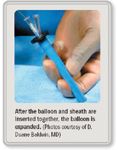Article
One-step sheath may offer safer stone removal
Honolulu--A new "one-step" percutaneous access sheath may become the next advance in the evolution of percutaneous nephrostolithotomy, according to D. Duane Baldwin, MD, associate professor of urology at the Loma Linda (CA) University Medical School. Dr. Baldwin has completed the first trials of the device, which weds the dilation balloon to the sheath, allowing the instrument to be advanced to the kidney in a single procedure.

"We feel that this is the next step in the evolution of these sheaths," Dr. Baldwin said.
"The sheath is folded over the uninflated balloon," he explained. "The balloon and sheath are inserted in a single step. Following balloon expansion, the sheath is in place ready for use. Once inserted, the procedure [nephrostolithotomy] is the same as established procedures."

Overall stone-free rate was 87%, which was defined as residual fragments as 4 mm or less. There were no complications resulting from renal access, although one morbidly obese patient required the substitution of an extra-long sheath to obtain access, according to Dr. Baldwin, who presented the findings at the annual Kimbrough Urological Seminar here.

"We did a number of procedures in animal models and compared a number of parameters, the most significant of which was time to insertion," he said. "We measured that from the time the instrument first touched the skin to the time we were first able to visualize the collecting system. In these studies, we found a 50% reduction in insertion time with no difference in insertion difficulty, blood loss, or ability to visualize the collecting system.
"One of the things we are excited about is using the device for upper pole access," Dr. Baldwin said. "I have had trouble on occasion with the standard device. The balloon is inserted and there is pressure to the ribs when inflated. When the sheath is advanced, it can hang up on the ribs because of this pressure. We have noted, when using this device in our patients, that there is a substantial reduction in this problem, although this is a purely subjective observation."
Lori Schlunt MD, a resident working with Dr. Baldwin, developed an in vitro model to test insertion forces. She found that, in the supracostal approach, the force was two to three times greater for the standard device compared with the new device.
Dr. Baldwin said he thinks the new device will reduce trauma that results when sheaths are inadvertently advanced too far. He noted that studies comparing the two-step device to earlier multi-step devices showed a significant reduction in perforations. He anticipates that a one-step procedure will further reduce perforation rates.





